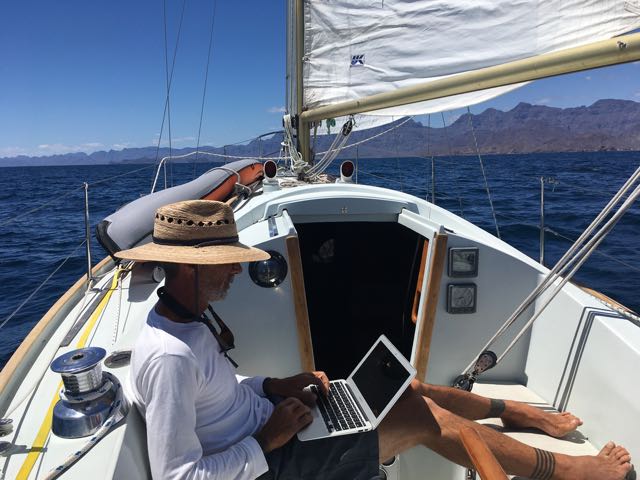|
If you are reading this at eos.earth -- at the top of this page you see a lone boat anchoring in an ancient volcano. We anchored there, swam to shore and climbed what was left of an old volcano to take this photo. That is our home anchored out there in San Francisco, perhaps 50 miles north of La Paz, Mexico in the Sea of Cortez. Those mountains in the background are ~ 5,000 feet high and about five miles away.
If you will remember, we were leaving China after my job was made illegal, yet did not know where we wanted to live. So, an expedition sailboat would allow us to wander around and see what the world was really like. Scientists were talking of things like not knowing where the rains would be in the future and not being able to predict the weather as we had gotten used to. So, if nobody knows what is going on -- we will go look ourselves. One common practice for people wanting to cross the Pacific Ocean on a small boat is to buy one in California and then sail it down to Baja California to prepare for the year long journey. This particular anchorage is perfect for such practice. So, we went and bought a one month supply of provisions -- food, water, rum, coffee, toilet paper -- think of all the things you buy in 30 days -- and go buy them all at one time. And if you forget anything, you have a whole month to think about that chocolate that you did not buy... Then you sail from the city of La Paz to San Francisco and put out the anchor and stay there for 30 days. If you need exercise, you swim in the sea, catch a fish, etc. The goal is to just be there for a month over and over -- learning how to buy, store and prepare food. How to live on a 32 foot boat and call it home. Why? Well, to sail across the Pacific Ocean we will be away from civilization for up to 30 days at a time. During the second half of the year long trip, the islands are only about one week apart, each -- but during the beginning half of the trip we will need to be able to be autonomous for up to 30 days at a time. So, when we say we performed a five year experiment on ourselves this is what we mean. Really just practice... When buying Eos we applied the same method that we would to solve any academic problem when you are learning something new. Go to the library and read all that you can about the subject. Then try to apply the lessons learned to create the desired result. What was the result we wanted? To work on the ocean and not on our boat, my wife said. So, we decided to test a proposal Lin Pardey, a famous long distance sailor, made in one of her essays from decades ago. She interviewed sailors on boats from 28 feet to 60 feet or something like that -- asking how long they have sailed -- plan to sail -- how much money they have / need to sail. And the summary of those writings was that even if you had unlimited money to spend, the smaller your boat was the longer you tended to stay out at sea. My wife and I read that average boat ownership to be about three years. We were shocked. It took us longer than three years to learn all systems on Eos. It would drive me crazy to have to learn a new boat every three years. But, after almost six years of living out here has shown us -- boat ownership does in fact get shorter as the boat gets longer. I believe it might be the complication of modern systems -- sometimes feeling like you need a PhD to read the directions of some tools on a modern sailboat! And that even if you do have money -- you still need to spend a lot of time a year fixing / maintaining all those things. And that seems to tire people out and make them not love the experience of a simple life out here... So, the experiment we chose to perform on ourselves was -- can we live in a small, simple, tiny luxury, minimalist sailboat and not feel like we are living in a rain barrel? Is it really cheaper? More simple? And with 100% certainty I can tell you -- yes -- it is enough. More than enough. And because she is so small, when we do need to pull into a marina it is affordable. At present, we are passing hurricane season in a marina with plans to, once again, attempt to film baby whales being born and the first month or two of life -- a magical experience so far. After that, all plans are written in the sand at low tide. M
0 Comments
Leave a Reply. |
Michael Sylvester
|


 RSS Feed
RSS Feed